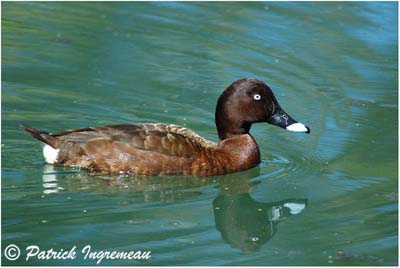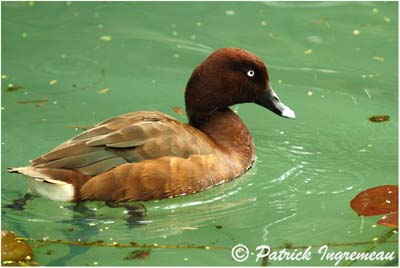
Hardhead
Aythya australis
Anseriforme Order – Anatidae Family
BIOMETRICS:
Length : 42-59 cm
Weight : M : 900g – F : 840g
DESCRIPTION:
Hardhead is a diving duck, sometimes named White-eyed Duck.
Adult male has dark brown-chestnut head, neck and body. Upper wing is dark brown, with washed reddish coverts. We can see broad white stripe on primary and secondary coverts.
Under tail is white. Underparts are whitish to white, but they can be brownish sometimes and often spotted with dark markings. Under wing is white with brown edges.
Bill is blackish with grey-blue to whitish subterminal band and black nail. Eyes are very pale, almost white. Legs and webbed feet are grey.
PROTECTION / THREATS / STATUS:
Hardhead is common and widespread in its range, but this species will be threatened in future by drainage of wetlands and degradation of its wet habitat.
Fr: Hardhead
All : Tasmanmoorente
Esp : Porrón Australiano
Ital : Moretta australiana
Nd : Australische Witoogeend
Photos de Patrick Ingremeau
Son site : TAMANDUA
Texte de Nicole Bouglouan
Sources:
HANDBOOK OF THE BIRDS OF THE WORLD vol 1 by Josep del Hoyo-Andrew Elliot-Jordi Sargatal - Lynx Edicions - ISBN: 8487334105
GUIDE DES CANARDS, DES OIES ET DES CYGNES – de Steve Madge - Delachaux et Niestlé - ISBN: 2603013769
Wikipedia (Wikipedia, The Free Encyclopedia)
Birds in backyards (Birds Australia and Australian Museum)

Adult female resembles male, but brownish and paler, with pale throat. Eyes are brown. Bill is different, with narrower subterminal band. She is smaller than male.
Juvenile is similar to female but paler, yellowish-brown, with belly spotted with dark markings.
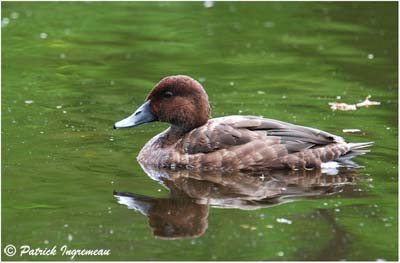
VOICE:
Hardhead is relatively silent outside breeding season. During courtship displays, male utters soft, wheezy whistles, and “whirr”. Female utters loud, brief rattling call “gaark”.
HABITAT:
Hardhead lives in freshwater wetlands and marshes, and sometimes sheltered estuaries. It frequents mainly deep open waters, and needs densely vegetated wetlands for breeding.
RANGE:
Hardhead is found in Australia. It can be occasionally found in New Guinea and other islands. It is common in the south-east of Australia, and in the wet countries near coasts.
BEHAVIOUR:
Hardhead feeds by diving in deep water. It can swim up to 40 metres under the surface. Its webbed feet help to propel it. It also feed by dabbling or by tipping up its body. It is able to stay submerged for one minute.
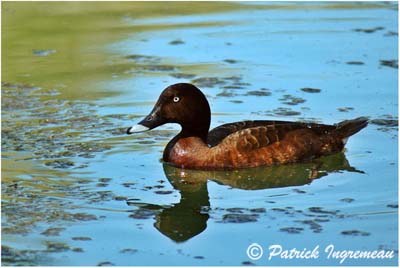
Hardhead is gregarious and lives in small groups or large flocks of thousands birds in dry season. This species is wary and takes flight rapidly if disturbed.
It is sedentary if there is available water. But after dry season, they are dispersive and travel long distances, outside their usual habitat.
Hardhead swims with body relatively low into water, with dropped tail. It never perches in trees and it is rarely seen on land.
FLIGHT:
Hardhead is able to take off rapidly from water. It has fast flight.
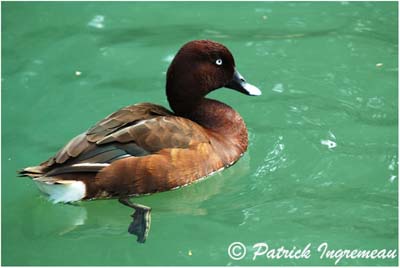
REPRODUCTION:
Breeding season is variable, according to the rainfalls. Usually it occurs from October to December in the South-east, and from September to December in New South Wales.
Hardhead’s nest is situated in low, dense vegetation, in or close to water, among reeds, sometimes on the shore or in islets.
Female builds the nest, with trampled reeds, sticks and other vegetation. It is a platform lined with down.
She lays 9 to 13 eggs. She incubates them alone during about one month. She rears the young alone.
DIET:
Hardhead feeds mainly on aquatic invertebrates such as mussels and freshwater shellfish. It also consumes aquatic plants and their seeds.
